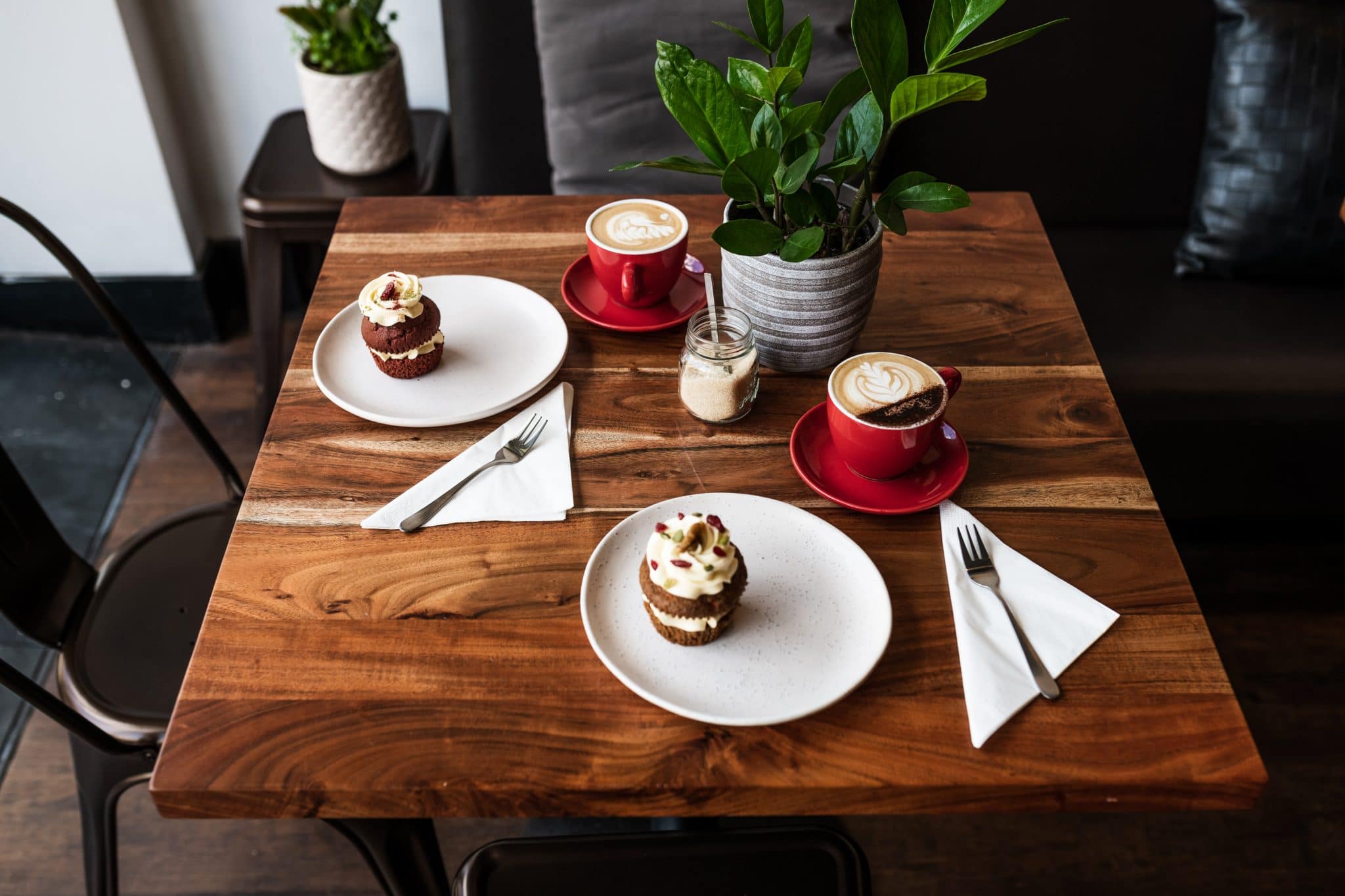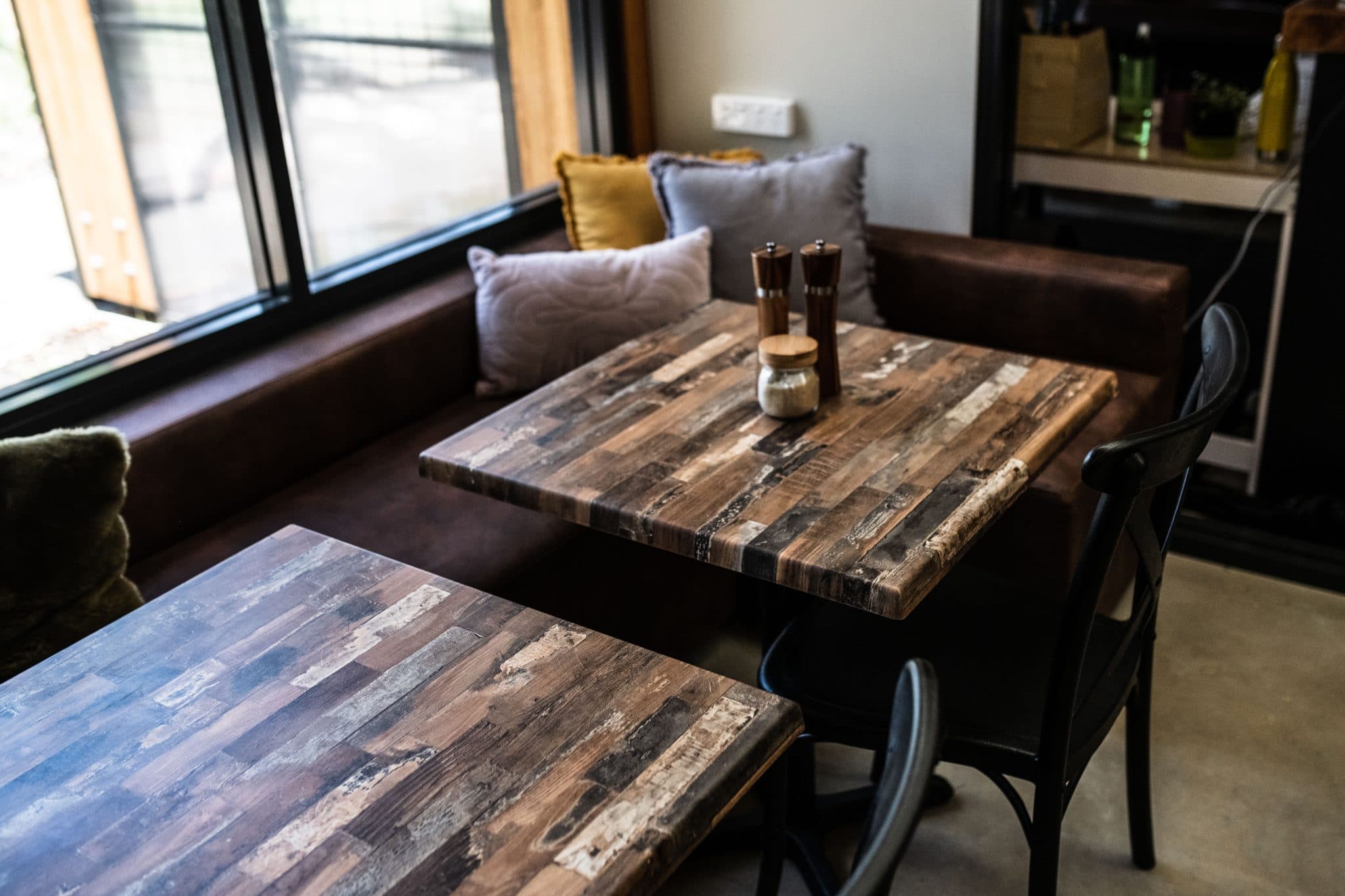Create the perfect café experience with the tables of your dreams. Everyone likes to take a break sometimes and enjoy a nice cup of coffee and cake. Having the perfect table will enhance the experience your patrons enjoy and keep them coming back.
We understand buying new tables for your café can be a daunting task, especially if you’re unsure of what the venture might cost you. That’s why we’ve put together a pricing guide to aid you in making your decision.
This guide will run you through a few different reasons why there is a difference across the industry in the pricing of the café table options.
What is the cost of Café Table Tops?
When you are looking for your table tops, the large range in pricing across the industry is largely due to the materials that are used. The quality of the materials that are used will drastically alter the price of the table top. For example, table tops that are created from a natural resource, such as marble or slate, will be much more costly than a table top created from a man-made product such as laminate or resin.
Natural table tops, such as slate and marble, cost so much more due to the cost to cut and produce the tops to the correct standard. The natural beauty and quality of these tops is amazing; however, they also ask a much higher price.
Alternatively, if you are still wanting a natural table top, you could look at timber. Whilst these are still more costly than laminate or resin, they don’t ask nearly as much as their marble and slate counterparts. Created from a variety of timbers – from Australian Hardwoods through to Asian timbers – timber table tops vary greatly with their pricing. The priciest timber table tops would be those locally manufactured from Australian hardwoods. This is because the products are created in Australia with limited resources and a much higher labour cost.
Alternatively, imported Indonesian or Indian will cost less than locally manufactured options, but they will still be of excellent quality.
The cheapest of the timber table tops would be the Asian versions, where the timber used is of inferior quality and often doesn’t withstand the varied climate of Australia.

On the other hand, you might decide to go for a laminate option. Pre-laminated table tops are the more cost-effective version of the laminate tops. These tops come in a wide range of colours and tend to be better value than their compact laminate cousins. However, pre-laminated table tops can’t be used outdoors, whereas compact laminate can be. Compact laminate tops can boast a thin profile, whilst being hardy and weather-proof. For these reasons, they can ask a higher price than the pre-laminated versions.
Perhaps the most commonly used table top would be the resin table tops. Here at Adāge Furniture, we refer to these as Gentas Table Tops, but you may have heard of them as SM France Table Tops or Isotops. These tops are the most popular in the industry because they are the most cost-effective table top on the market. They are strong, moulded tops that offer beautiful finishes and ask a reasonable price. Because these tops aren’t created from solid natural materials, such as timber or marble, and the process to create the tops is much simpler than the process to create a laminate top, these table tops tend to be the least expensive quality table tops on offer in the industry.
Once you’ve chosen your table top, you’ll need a base to put it on. Much like table tops, materials are a great factor on the cost of your table base, however they aren’t the only factor.
What is the cost of Café Table Bases?
Table bases range from a variety of materials, from standard steel to aluminium to cast iron, with the most expensive being stainless steel.
The reason standard steel is the least inexpensive is because it is in abundance. It is the easiest material for manufacturers to get a hold of, and therefore it is the easiest for suppliers to supply at great volumes.
Next on the ladder are the cast iron bases. These bases prove to be more costly than standard steel as they require moulds for each base. Each mould is created for each individual style, and this takes time and resource. Therefore, these bases tend to cost a little more.

Stainless steel is the most expensive material for table bases due to the additives in the product. These bases are corrosive resistive due to the additives in the steel, and therefore are a great option for cafes near the ocean or areas that receive a lot of rain. Within the stainless steel bracket, there are further price levels. The least expensive stainless steel is #201, which is a Chinese version that is very inferior and cannot be used outdoors. #304 is the most commonly used stainless steel as it is a great all-rounder – with great quality, but still asking a reasonable price. The top stainless steel would be the marine-grade #316, which is very expensive and therefore rarely used for table bases.
However, the materials that the table bases are made from aren’t the only factor affecting the price you’ll pay. Some table bases come with extra features – like the ability to fold away or to self-level. These mechanisms can make your life as a café owner much easier, however they do add to the price you’ll pay for the base.
Self-levelling table bases, such as NOROCK table bases, tend to be more expensive due to the self-levelling mechanisms that make them unique. These table bases are extremely helpful with their ability to self-level on any surface; however, they do cost more than a table base that can be manually levelled using the adjustable feet.
Some table bases also have the ability to fold and stack into each other for easy storage. These table bases also cost more than an average base due to the mechanisms inside the base that allow it to fold and it in beside each other. If you’re looking for a table that can be folded up and stacked away neatly, then these bases are for you! They’re a great way to make your packing up life easier.
Whilst looking across the entirety of the café table range, there is a distinct factor that affects the cost of the furniture, regardless if it is a table top, table base, or a ready-made table. That is the origins. Different manufacture origins produce furniture of different costs and there is a distinct trend that can be noticed across the board.
Do the manufacture origins affect the price of Café Tables?
Do the manufacture origins affect the price of Café Tables? Short answer? Yes.
As with all furniture, the manufacture origin will affect the cost of the product. Different countries use different methods of manufacture, all with varying standards of quality. The varied standards of quality lead to a great difference in the price that you will pay for your café tables.
Often, furniture that is created in Asian countries will cost a lot less than furniture that is manufactured in Europe or Australia. Products in Asia tend to be mass-produced, with minimal costs and much lower standards of quality. The materials used are often inferior and cost less for the manufacturer, and therefore can be sold at a cheaper price.
Alternatively, many European manufacturers maintain tight quality controls in their warehouses and their focus is to produce products of high quality. They tend to embody the “Quality, not Quantity” mantra. These manufacturers come from a long line of craftsman, and they take pride in their – producing items of art, with fantastic workmanship. However, tight quality control must also be maintained by the importer of the table top or base to ensure that the products being imported remain of the best quality.
With all Cafe Tables, you can be sure that the higher quality furniture will cost you more. Furniture that is manufactured in any European country will always ask a higher price than their Asian counterparts. Similarly, locally manufactured tables will also cost more. This is mainly due to the higher quality raw materials used, and the quality control that is maintained in the factories. The furniture is crafted to last, while cheaper versions are created in mass quantities with little attention paid towards quality. As with anything in life, you can expect to get what you pay for.
